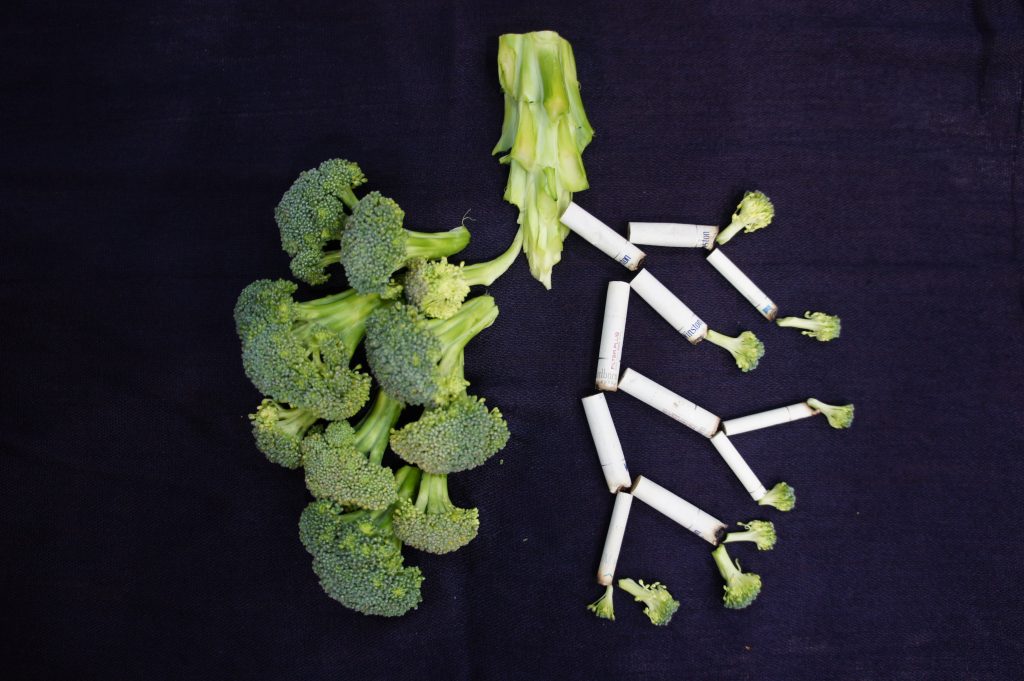Today, Aug 1, is a special day – National Lung Cancer Day. This day aims to raise awareness of lung cancer and lung health and support lung cancer-related research. Although the word “lung cancer” is familiar to us, most of us barely know about the disease. So, we’ve chosen this day to share some information about lung cancer in the hope that it will help you and your family live healthier lives.
According to the latest Global Cancer Burden Report, released by the Journal of the American Medical Association at the end of 2019, lung cancer is the world’s leading cause of death and the most common cancer in China; nearly 700,000 Chinese people develop lung cancer each year.
What Is Lung Cancer?
Cancer is a malignant tumor, a sarcoma made of cells that replicate indefinitely and never die. As the name implies, lung cancer refers to a malignant tumor originating in the lungs, which is composed of stacked epithelial cells. Once these epithelial cells have a genetic mutation that causes them to divide uncontrollably, cancer is induced.
There are two types of lung cancer, with about 85% of cases classified as non-small cell lung cancer (NSCLC) and the rest classified as small cell lung cancer (SCLC). As their names suggest, in non-small cell lung cancer, the cells that make up the tumor are larger; in small-cell lung cancer, the cells that make up the tumor are small. That’s the most significant difference.
In addition, non-small cell lung cancer develops much more slowly than small cell lung cancer. After the onset of symptoms, if the disease is allowed to develop without any treatment, the survival rate of SCLC patients is only 2 to 4 months, while that of NSCLC patients is seven months. The five-year survival rate for SCLC patients is only 5 to 10%, compared with 24% for NSCLC patients.
Symptoms of Lung Cancer
Any illness of the respiratory system is bound to lead to chronic cough and a loss of breath. In addition to these basic symptoms, lung cancer has all sorts of indirect effects on the body. For example, a cancer cell’s presence triggers an immune response, causing lung cancer patients to face fevers, weight loss, night sweats, and so on. If the tumor presses down on the respiratory tract, it can cause shortness of breath and chest tightness or even pneumonia; if a tumor presses down on a nerve in the lung, it causes pain around the chest and may lead to changes in a person’s voice. If a tumor compresses blood vessels, it can cause muscle weakness or facial swelling.
Lung cancer’s possible symptoms include a chronic cough, shortness of breath, fever, weight loss, sweating, pneumonia, chest pain, hoarseness, facial swelling, and muscle weakness. If you have these symptoms, medical attention is advised.

As this picture creatively conveys, smoking cigarettes dramatically reduces the lungs capacity to work
Lung Cancer Prevention
So, how can one prevent lung cancer? There are many different causes of lung cancer, including smoking, air pollution, heredity, ionizing radiation, long-term exposure to certain chemicals, and so on. One of the most controllable and remarkable factors is smoking. 90% of all lung cancer cases are now linked to smoking. Smokers are 15% to 30% more likely to develop lung cancer than nonsmokers, both in the primary and secondary smoke categories. One reason is that cigarette smoke destroys the cilia on the surface of the respiratory tract, allowing toxins, bacteria, viruses, and cancer-causing agents to enter the lungs unimpeded. Tobacco itself, meanwhile, contains more than 70 cancer-causing chemicals. Once in the lungs, they make connections to the DNA of the epithelial cells, easily changing the DNA arrangement of those cells. Shuffling the DNA sequence is likely to lead to genetic mutations and, subsequently, the formation of cancer cells, which are capable of dividing rapidly, averting programmed cell death, and fooling the immune system into identifying them as benign cells. The repeated stimulation of carcinogens to epithelial cells greatly increases the chance of cell mutation and cancer. This is why smoking and lung cancer are so closely associated.
Quitting smoking is the best way to prevent lung cancer, even for those who recognize themselves as occasional smokers. A study by the Centers for Disease Control and Prevention studies a group of smokers for ten years and found that those who quit within the ten years were half as likely to develop lung cancer as those who did not quit.
Lung Cancer In Beijing
To ensure public health, Beijing is also actively regulating tobacco. The Regulations on The Control of Smoking in Beijing came into effect on Jun 1, 2015, and its effect has been remarkable. Smokers made up 23.4% of Beijing’s population in 2014; Just five years later, that number had fallen to 20.3%. Considering that 31.3% of Beijing’s citizens are exposed to second-hand smoke, the city government has put a lot of effort into regulating and restricting smokers’ smoking places to ensure that they do not affect the health of the general public, especially children. Anyone who has lived in Beijing will have noticed to some extent that fewer and fewer people smoke in public places in recent years. This is because the Beijing municipal government strictly prohibits smoking in indoor public places such as subway stations, hotels, shopping malls, and in places where minors gather, such as kindergartens, primary and secondary schools, and children’s hospitals. Under the Healthy China Initiative 2019-2030, China plans to reduce the national smoking rate to less than 20% by 2030. Based on current trends, this goal is within reach! And, this will certainly improve the lung health of the Chinese Public.
Treatment of Lung Cancer
There are many treatment options for lung cancer patients, including surgery, conventional chemotherapy, radiotherapy, targeted therapy, and immunotherapy.
The curative effect of surgical removal is the best. Direct removal of tumors from the lung is the quickest and easiest way. But there are a lot of limitations. For example, surgery should be performed only when the cancer is detected early and when the tumor has not spread or metastasized, otherwise it will damage a large portion of the organ. In addition, patients must have strong immunity and self-healing ability; otherwise, the wound can be easily infected.
Conventional chemotherapy can also be very effective in killing cancer cells, but the damage to the body is enormous. Chemotherapy drugs target all rapidly dividing cells from head to toe, including not only cancer cells, but also blood cells, hair cells, intestinal cells, and a number of others extremely important to the human body. No matter what, it covers a wide area and kills cancer cells efficiently. It is most suitable for the rapidly developing small cell lung cancer and advanced non-small cell lung cancer which has already spread widely.
The risks of radiation therapy are lower than those of conventional chemotherapy and surgery. However, radiation does not kill large numbers of cancer cells in a short time; it slows the tumor growth, reduces the size of the tumor moderately, and treats a small number of scattered and residual cancer cells. Therefore, radiotherapy is often used in combination with surgical treatment or conventional chemotherapy.
Targeted drugs can effectively identify and get rid of cancer cells, without influencing the healthy ones. However, some patients face difficulty finding a targeted drug for their conditions, which are rather rare. Furthermore, long-term use of targeted drugs can easily lead to drug resistance in cancer cells. Therefore, if you cannot find the best-performing and most appropriate targeted drug on the market, you may consult your doctor and ask to join a clinical trial that suits your conditions.
Immunotherapy meanwhile, treats cancer by training the body’s immune system against cancer cells. The treatment removes the tumor once and for all, reducing the chance that cancer will return because it gives the body the ability to fight off the cancer cells on its own. Nevertheless, immunotherapy is not recommended for terminally ill patients who are weak. Firstly, if the tumor is too large, immunotherapy cannot eliminate it, but it can only moderate its growth. Secondly, immunotherapy takes about a year to kick in, so it’s not helpful for an emergency. Finally, while the immune system is being trained, the body needs to be healthy enough to withstand the inevitable side effects of an activated immune system, such as skin problems, diarrhea, and fever.
In general, the most effective treatment is for early-stage lung cancer. If it is detected early enough, it could be easily cured. Therefore, people exposed to tobacco carcinogens, roaming old age, and with a family history of cancer are highly encouraged to take regular medical examinations and develop healthy habits to promote a healthy, happy, and fulfilling life!
iBowu China 2020 is a team composed of 20 passionate biology students from 11 different high schools, mainly in Beijing. They come together to tackle a synthetic biology competition named iGEM. Their project focuses on the targeted liposome delivery of magnetic protein crystals to lung cancer cells, followed by an alternating magnetic field induced magnetic hyperthermia. If you would like to know more about them and their project, feel free to email ibowu-China2020@outlook.com.
Instagram: @ ibowuchina2020
Twitter: @ IbowuC
Facebook: iBowu China
喜马拉雅:iBowu_China2020
KEEP READING: Eh, What’s up Doc?: The Search for the Perfect Pediatrician
Images: Unsplash


